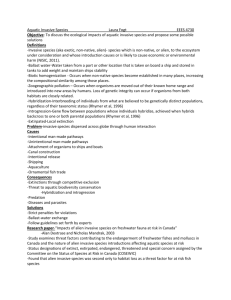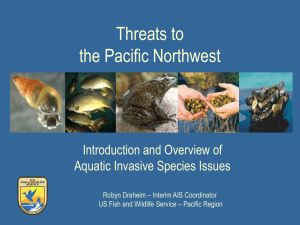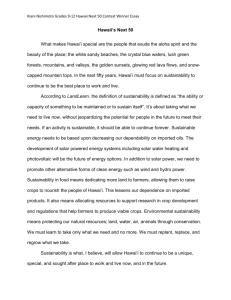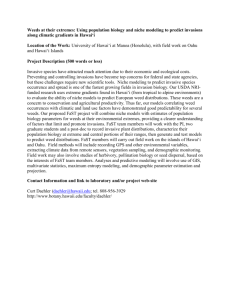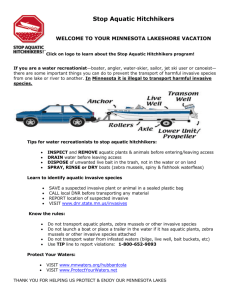Hawai`i`s Aquatic Invasive Species Partnerships:
advertisement
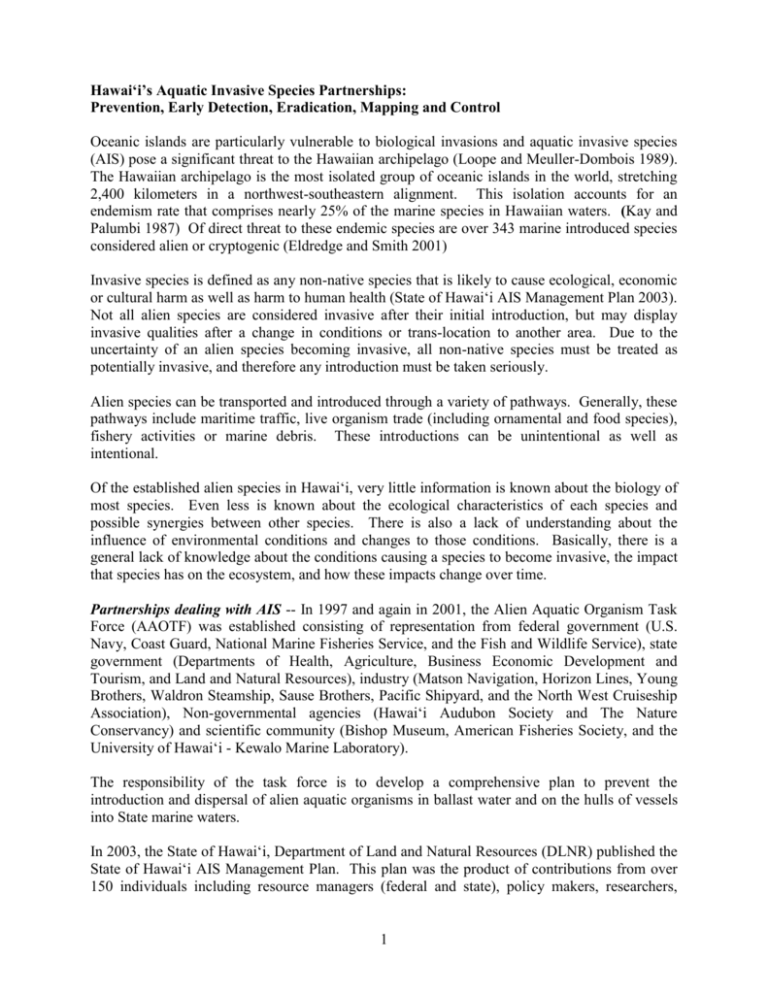
Hawai‘i’s Aquatic Invasive Species Partnerships: Prevention, Early Detection, Eradication, Mapping and Control Oceanic islands are particularly vulnerable to biological invasions and aquatic invasive species (AIS) pose a significant threat to the Hawaiian archipelago (Loope and Meuller-Dombois 1989). The Hawaiian archipelago is the most isolated group of oceanic islands in the world, stretching 2,400 kilometers in a northwest-southeastern alignment. This isolation accounts for an endemism rate that comprises nearly 25% of the marine species in Hawaiian waters. (Kay and Palumbi 1987) Of direct threat to these endemic species are over 343 marine introduced species considered alien or cryptogenic (Eldredge and Smith 2001) Invasive species is defined as any non-native species that is likely to cause ecological, economic or cultural harm as well as harm to human health (State of Hawai‘i AIS Management Plan 2003). Not all alien species are considered invasive after their initial introduction, but may display invasive qualities after a change in conditions or trans-location to another area. Due to the uncertainty of an alien species becoming invasive, all non-native species must be treated as potentially invasive, and therefore any introduction must be taken seriously. Alien species can be transported and introduced through a variety of pathways. Generally, these pathways include maritime traffic, live organism trade (including ornamental and food species), fishery activities or marine debris. These introductions can be unintentional as well as intentional. Of the established alien species in Hawai‘i, very little information is known about the biology of most species. Even less is known about the ecological characteristics of each species and possible synergies between other species. There is also a lack of understanding about the influence of environmental conditions and changes to those conditions. Basically, there is a general lack of knowledge about the conditions causing a species to become invasive, the impact that species has on the ecosystem, and how these impacts change over time. Partnerships dealing with AIS -- In 1997 and again in 2001, the Alien Aquatic Organism Task Force (AAOTF) was established consisting of representation from federal government (U.S. Navy, Coast Guard, National Marine Fisheries Service, and the Fish and Wildlife Service), state government (Departments of Health, Agriculture, Business Economic Development and Tourism, and Land and Natural Resources), industry (Matson Navigation, Horizon Lines, Young Brothers, Waldron Steamship, Sause Brothers, Pacific Shipyard, and the North West Cruiseship Association), Non-governmental agencies (Hawai‘i Audubon Society and The Nature Conservancy) and scientific community (Bishop Museum, American Fisheries Society, and the University of Hawai‘i - Kewalo Marine Laboratory). The responsibility of the task force is to develop a comprehensive plan to prevent the introduction and dispersal of alien aquatic organisms in ballast water and on the hulls of vessels into State marine waters. In 2003, the State of Hawai‘i, Department of Land and Natural Resources (DLNR) published the State of Hawai‘i AIS Management Plan. This plan was the product of contributions from over 150 individuals including resource managers (federal and state), policy makers, researchers, 1 educators, representatives from the shipping, aquaculture, aquarium, and tourism industries, active ocean and inland water users, as well as other stakeholders throughout the State. The State of Hawai‘i AIS Management Plan contains 7 main sections. One section includes 26 items to be accomplished for Coordination and Collaboration. To date, 6 of the 26 items have had significant progress while another 14 have had some progress. Currently, the State of Hawai‘i, DLNR addresses AIS in four main themes. The themes include prevention, early detection, eradication and control. Prevention – Prevention activities have mainly been focused on two areas: transport of organisms through maritime vectors and an educational campaign to teach people how to be responsible pet owners. The management of maritime vectors has included the development state regulations for the discharge of ballast water with assistance from the U.S. Coast Guard and existing federal regulations. Currently, the state is looking at ways to better managing the transport of organisms through other maritime pathways such as hull fouling and sea-chest fouling. One mechanism used to assist with gathering input from all involved stakeholders was the development of the AAOTF. DLNR has also used a national educational campaign (developed by U.S. Fish and Wildlife Service (USFW), National Oceanic and Atmospheric Administration (NOAA), and the Pet Industry Joint Advisory Council (PIJAC)) to teach the public not to release unwanted aquarium pets into our streams, waterways and oceans. This campaign is a partnership between USFWS, NOAA, PIJAC, DLNR, Waikiki Aquarium, Hawaiian Humane Society, and interested aquarium industry representatives) Early Detection – DLNR is in the early stages of developing of a system to quickly detect new introductions of organisms into state waters. In marine habitats, this will be largely focused in harbors and other embayments while other coastal sites and freshwater habitats will rely on reports from the public and researchers routinely in the field. This goal can only be achieved through increased partnerships and support from federal partners. One reoccurring issue with the development of a marine early detection system is the taxonomic expertise required to detect and catalogue new discoveries. DLNR will work closely with the Bishop Museum and the University of Hawai‘i - Hawai‘i Institute of Marine Biology to solve these issues. Eradication – Once organisms are detected and their distributions are determined to be limited, eradication should always be the action of choice. If the organism is left unchecked or simply maintained, costs for such management will become enormous for all partners involved. However, the single largest obstacle in eradicating aquatic invasive species is the lack of tools or technology available to eradicate aquatic populations. One controversial tool that needs to be considered is the use of chemicals in marine and freshwater environments to rapidly respond to new invaders. DLNR will be addressing this issue through EPA and the State Department of Health. Mapping and Control – Once species have become established and widely spread, controlling the population is the only management option other than ignoring the problem. However, in order to minimize the spread of existing AIS, the boarders and fringe populations need to be mapped. Knowledge of existing distributions can give managers a better chance at controlling fringe populations to minimize further spread. 2 One example is the attempt to control alien algae by a strong, local partnership (Hawai‘i Marine Algal Group (HIMAG)) consisting of DLNR, University of Hawai‘i and The Nature Conservancy with significant federal funding and input. This partnership manages an ongoing project to vacuum alien algae from local coral reefs at or near the fringe of the population. Partnerships such as HIMAG are often the only effective way to deal with large-scale problems like alien algae, and HIMAG may be a model for dealing with other large-scale issues. How Can Federal Partners Help? Increase collaboration and communication between military partners and State government in addressing the transport of aquatic invasive species through ballast water and hull fouling into Hawaiian waters. Maintain and increase support for ongoing research for aquatic invasive species in Hawai‘i. Increase support for dealing with regulatory issues for the use of chemicals in an aquatic environment. Increase funding for the development of taxonomic expertise at local levels to be used for early detection. Support the development of new tools for the control and eradication of aquatic invasive species. Work with state and local agencies to address issues dealing with aquaculture of nonnative organisms. 3

